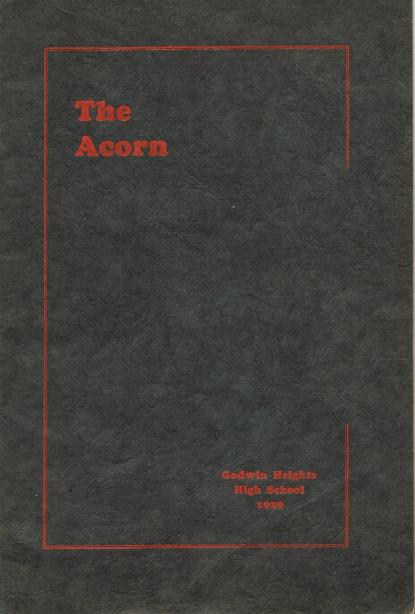

The Godwin class of 1929 is distinctive in a couple of ways. It was the last class to attend only the one room school house and the new ( in 1924 ) school along Division Avenue. Starting in the fall of 1929 students would attend and graduate from the new ( in 1929 ) high school building on Allen Road, later to be called 36th Street.
It was also the last class before the Great Depression started on October 29, 1929, also known as Black Tuesday, with a financial panic on Wall Street. Although the Great Depression took a few years to really get going, the effects were dramatic and pervasive. Land platted for development, with entrance pillars and other ornaments in place, and still visible in a few areas, were summarily abandoned.
It was probably just luck that the new high school building on 36th was completed before the Great Depression struck. The class of 1929 lived in a time of general, if artificial, prosperity, whose excesses the world over finally produced a catastrophe. The class of 1930 was probably mostly spared the effects of the economic collapse, but subsequent classes surely were not. One measure of the prosperity was the famous trip to Yellowstone National Park. Chaperoned by the ever energetic Saurs, the trip was noted by many area newspapers, and in 1929 must have been quite an adventure in every respect.
It is easy to see the influence of the flapper era in the hair arrangements, and other aspects of dress. Men's hair seemed to be in a transitional phase, with some still wearing the part down the middle seemingly characteristic of the 19th century, and others had seemingly more contemporary cuts, with a part on one side or the other.
It's likely that the Godwin area still had a largely rural flavor to it. Descriptions of the area in 1925 suggest there were few businesses along Division Avenue around Godwin yet. Many of the original farms and farm houses still existed.
But it was also an era of rapid growth, until the Great Depression struck anyway. The Michigan Electric Company Interurban system, completed in 1913, allowed many to live in any around Godwin, and work in the city. After the financial collapse of the system, the Division Avenue Bus Line took up much of the slack, as did automobiles by that time. Many of the neighborhoods east of Division Avenue were built in the 1915 to 1928 time frame, coincident with the time the interubran system operated.
Some of the growth also resulted from workers coming from Grand Rapids during WWI to work on the Picric Acid plant on the southwest corner of Clyde Park and 44th Street. A stop on the interurban line, this growth probably influenced the Home Acres area more than the Godwin Heights area.
As of 2003, any surviving members of the 17 students making up the class of 1929 would now be about 92 years old. Sadly, it is generally much harder to track the stories of the female members of the class because of the last name changes. Hopefully more information will become available. Merle Mullikin was class valedictorian in 1929. It seems that the women in the early Godwin classes were the more successful students, and most of the early classes had female valedictorians. Most of these were no doubt quite successful in their later lives, but it is not always easy to find out what became of them.


The cover of the 1929 class annual "The Acorn."
The bottom right reads "Godwin Heights High School 1929"
The reason the annual was called "The Acorn" is not presently known. It might be a play on the notion that Godwin students were acorns, and would grow into sturdy oaks in their community. Perhaps it is related in some way to the oak trees in front of the old library building, perhaps the oldest existing features of the school system now. They were there when the one room school house was photographed in about 1900, and were perhaps there when the one room school house was built in 1867. But for now no one seems quite sure.
The entire 1929 edition of "The Acorn" is presented below. To view pages of The Acorn, simply left click on the page numbers. Each page has been scanned at about 150% of its original size in order to make some of the details easier to see. You might have to move the image around in your browser in order to see it all. Be sure to make your browser full screen size for easier viewing.
Be sure to scroll all the way to the bottom of each page; comments and notes are included on some of the pages. Use the "Back" button on your browser to return to the main menu. People should consider contacting me if they have additional information, or comments.

If anyone has any other photographs pertaining to the class of 1929 they'd like to see included here please contact me.

